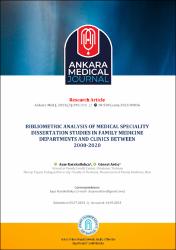Bibliometric analysis of medical speciality dissertation studies in family medicine departments and clinics between 2000-2020
Citation
Karakullukçu, A. & Ardıç, C. (2023). Bibliometric analysis of medical speciality dissertation studies in family medicine departments and clinics between 2000-2020. Ankara Medical Journal, 23(3), 295-311. http://doi.org/10.5505/amj.2023.90836Abstract
Objectives: This study aimed to conduct a bibliometric analysis of medical specialty dissertation studies
conducted in Family Medicine departments and clinics between 2000 and 2020.
Materials and Methods: This descriptive study was conducted between 2000 and 2020 by examining 1628
dissertations in the field of family medicine specialization. In the first process, information regarding the
dissertation was recorded. In the second process, the conversion of dissertations into articles was evaluated.
The journal indexes, Q classification and citation numbers of the dissertations publications were determined.
Results: 1009 (61.98%) of the students were female. 977 (60.01%) of the dissertations belonged to university
hospitals. The number of dissertations in which the title of advisor associate professor was 579 (35.56%).
Preventive health services were the most frequently selected topic in the dissertations (8.66%).
Descriptive/cross-sectional studies were the most preferred research type, with 1414 (86.85%) dissertations.
Project support, laboratory, and radiological tests have decreased significantly over the years (p<0.05). 458
(28.13%) of the dissertations were published in any journal. Considering the databases of the publications, 92
(20.09%) were published in SCI/SCI-Expanded.
Conclusion: About a quarter of the theses have been published in any journal, and there has been a noticeable
increase in publications in international indexes in recent years. Theses with research type of case-control,
intervention, laboratory and radiologic test use were more likely to be published. Concordantly, it is advised to
give precedence to studies situated higher on the evidence pyramid, allocate sufficient funds to finance
research, and increase backing for projects.


















